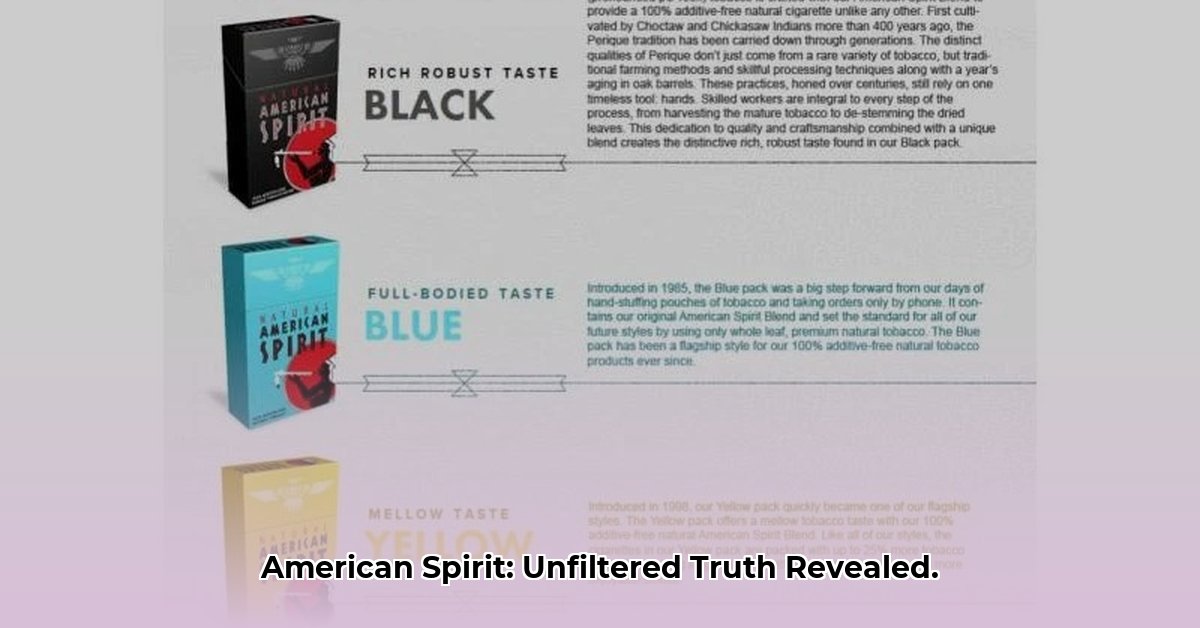Decoding the Colors: Your Guide to American Spirit Varieties
American Spirit cigarettes have cultivated a distinct image, often associated with “natural” and additive-free tobacco. But beneath the colorful packaging lies a complex array of blends, strengths, and flavors. This guide breaks down the American Spirit lineup, exploring the nuances of each variety, addressing common questions, and frankly discussing the inherent health risks of smoking.
Navigating the Spectrum: A Detailed Look at Each Type
This table provides a quick overview of the American Spirit lineup, categorized by color. While the brand emphasizes its natural and additive-free tobacco, it’s crucial to remember that all cigarettes pose serious health risks.
| Color | Flavor Profile | Strength | Organic? | Menthol? | Perique? | Notes |
|---|---|---|---|---|---|---|
| Yellow | Light, Smooth, Natural | High | No | No | No | Often referred to as “Natural Tobacco.” |
| Orange | Robust, Smooth | Medium | No | No | No | Contains organic guarana. |
| Blue | Mild, Light | Low | No | No | No | Generally considered to have the longest burn time. |
| Light Blue (Turquoise) | Full-Bodied, Classic | Medium-Low ? | Varies | No | No | Information varies; potential blend/regional differences. |
| Green | Mellow, Spearmint | Low | No | Yes | No | Infused with organic spearmint. |
| Red | Balanced, Mild | Medium | No | No | No | Often called the “Original Blend.” |
| Black | Bold, Strong, Perique Tobacco | High | Yes | No | Yes | Unfiltered, 100% additive-free organic tobacco. |
| Silver | Ultra-Light, Mellow | Extra Low | No | No | No | Organic sugarcane paper wrap. |
| Dark Green | Bold, Organic Menthol | Medium | Yes | Yes | No | A strong, natural menthol option. |
| Turquoise | Rich, Full-Bodied, Organic | Medium | Yes | No | No | Organic version of the Blue, potentially stronger. |
| Non-Filter | Unfiltered, Pure, Bold | High | No | No | No | Delivers the full impact of the tobacco. |
Exploring the Nuances: Flavor Profiles and Comparisons
-
Yellow: This “entry-level” American Spirit provides a smooth, light, and natural taste, often compared to Marlboro Gold. It’s a likely starting point for those new to the brand.
-
Orange: A step up in richness from Yellow, Orange offers a smooth yet robust flavor, potentially influenced by the organic guarana. Some smokers believe guarana adds a subtle energizing effect, although this is not scientifically confirmed. It’s often compared to Camel Blue.
-
Blue: A milder option, often associated with a longer burn time, Blue provides a light and smooth experience, somewhat similar to Marlboro Lights. However, the precise nicotine and tar content within “light” cigarettes can be misleading, as FDA regulations now prohibit these descriptors due to potential misinterpretations of reduced harm.
-
Light Blue/Turquoise: This variety presents some ambiguity. Sources conflict on its strength and flavor profile. Some describe it as a full-bodied classic, similar to Marlboro Red or Silver, while others suggest variations in blends or regional differences. More research is needed to clarify these inconsistencies.
-
Green/Celadon: Another ambiguous variety. Light Green (or Celadon) may offer a balanced flavor or potentially a menthol undertone. Dark Green is definitively a menthol option, providing a bold, organic coolness comparable to Newport.
-
Red (Original Blend): This balanced, mild option serves as a good middle ground, offering a classic American Spirit experience. Its “original” designation suggests it may represent a foundational flavor profile for the brand.
-
Black: Unique due to its Perique tobacco, Black delivers a rich, luxurious, and slightly spicy flavor, often likened to Dunhill Fine Cut Dark Blue. Its unfiltered, organic composition provides a distinctive, intense experience.
-
Silver: This ultra-light option caters to those seeking a milder, less intense taste. The organic sugarcane paper wrap may contribute to a subtly sweet flavor.
-
Non-Filter: For the purist, the non-filter offers the full, unadulterated taste of the tobacco, similar to non-filter versions of Camel or Lucky Strike.
Key Features and Cultural Context
American Spirit distinguishes itself through its additive-free tobacco and organic options (Gold, Black, Dark Green, and sometimes Turquoise). While “additive-free” might sound healthier, it’s crucial to understand that burning any tobacco produces harmful chemicals. The absence of additives does not eliminate the inherent risks of smoking. The brand’s color-coded packaging, while visually appealing, can also be misleading, as different colors may have varying nicotine and tar levels.
American Spirit has cultivated a particular image, often associated with a “natural,” “authentic,” or even “health-conscious” lifestyle. This perception, despite the well-established dangers of smoking, warrants further exploration. Ongoing research may shed light on the motivations and demographics of American Spirit smokers.
Nicotine and Tar Content: Understanding the Risks
While specific nicotine and tar levels for each American Spirit color are difficult to definitively pin down due to variations in testing methods and reporting, some studies suggest that American Spirits may contain higher levels of nicotine compared to other brands. This is an area of ongoing research, and more data is needed for a comprehensive comparison. It’s crucial to remember that the amount of nicotine absorbed can vary based on individual smoking habits and metabolism.
Regardless of nicotine and tar levels, all cigarettes pose significant health risks, including lung cancer, heart disease, respiratory problems, and nicotine addiction. Choosing an “organic” or “additive-free” cigarette does not eliminate these risks.
Frequently Asked Questions
-
Which American Spirit is the strongest? While nicotine levels vary, Yellow, Black, and Non-Filter are generally perceived as the strongest in terms of flavor and overall intensity.
-
What’s the difference between Turquoise and Light Blue? This distinction remains unclear. Some sources suggest they are the same, with “Turquoise” potentially referring to the organic version. Other sources indicate potential variations in blend or regional differences. Further investigation is needed.
-
Are all American Spirits organic? No, only Gold, Black, Dark Green, and sometimes Turquoise are designated as organic.
A Crucial Reminder: The Risks of Smoking
This guide is intended to provide information, not to endorse smoking. All cigarettes, including American Spirits, are harmful and addictive. The best choice for your health is to not smoke. If you are a smoker and want to quit, resources are available. Consult your physician or visit the CDC’s website on smoking and tobacco use for more information.
- Where to Buy Bento Boxes for Healthy, Organized Meals - December 9, 2025
- Plastic Bento Boxes Make Meal Prep and Cleanup Effortless - December 8, 2025
- Shop Bento Lunch Boxes on Sale Nearby Now - December 7, 2025










